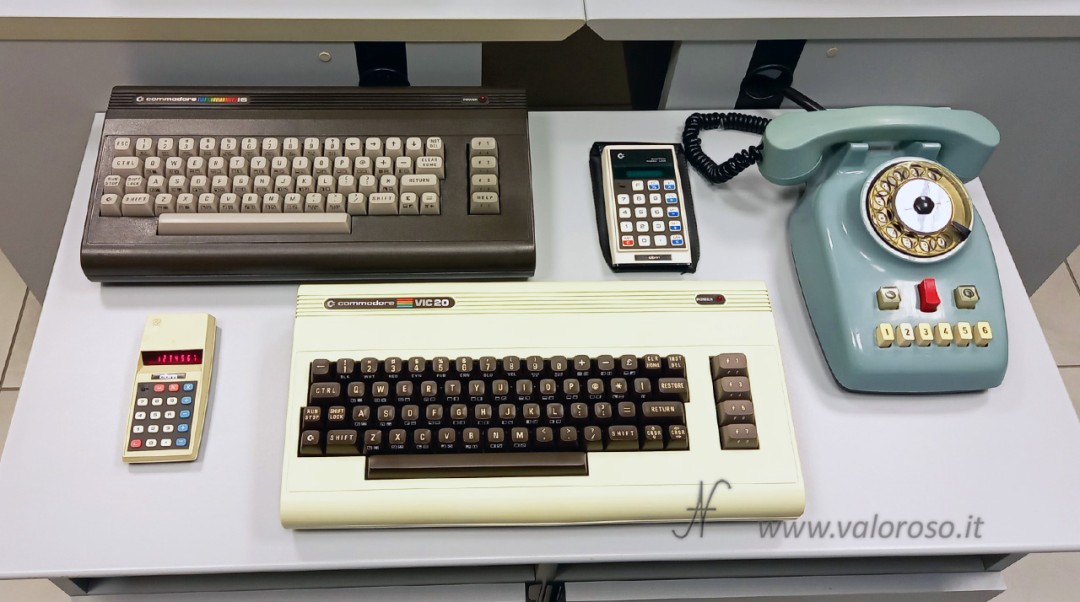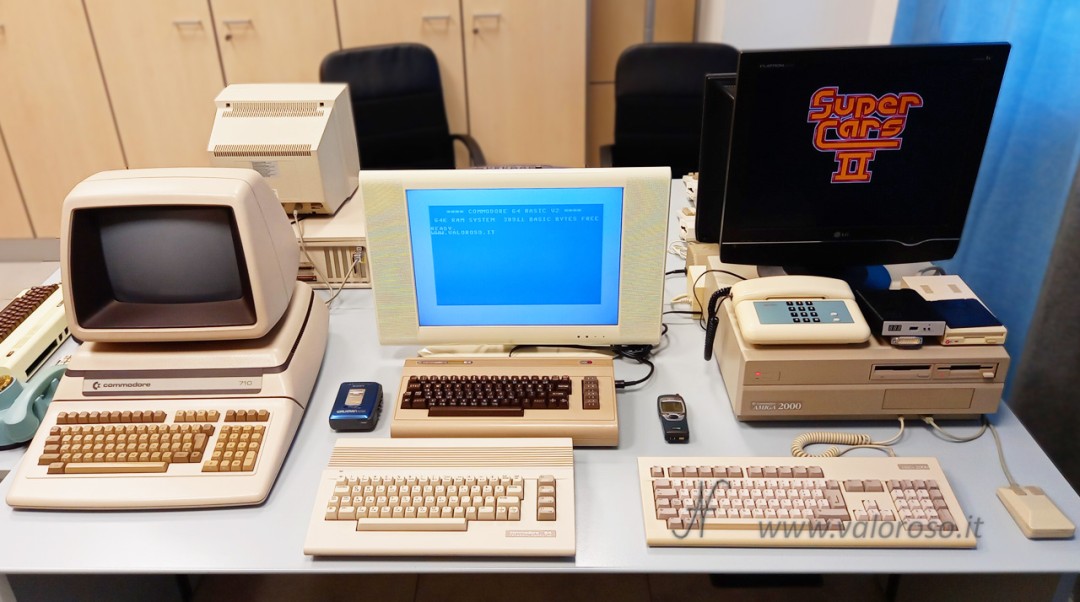Welcome to ValorosoIT! 🎉 Today I invite you to embark, with me, on a real journey through time, exploring the thematic path I have set up, mainly dedicated to the history of Commodore electronic devices. It starts from the 70s, to go up to the 90s, covering three decades of technological innovation. Although my personal computer collection starts from the 1980s, there are still some fascinating items from the 1970s, such as two CBM (Commodore Business Machines) calculators, the 776M and GL-989R, as well as a Safnat phone and other very nice items.

The beating heart of this journey is the Commodore brand, famous for having revolutionized the world of computers with the home computers of the 80s.
Commodore 128: the King of the 3 worlds
Let's start with one of the jewels in my collection: the Commodore 128, which I have owned since I was a child. Produced between 1985 and 1989, this model stands out for its "dual-core" architecture, being equipped with two microprocessors: the MOS 8502 and the Z80. This feature allows it to operate in three different modes: Commodore 128 mode, Commodore 64 mode (to ensure backward compatibility with the C64) and CP/M (Control Program for Microcomputers) mode. The latter operating system allows you to run professional software, also used for business management.
And here, finally, is a CRT TV paired with the Commodore 128. I usually use LCDs from the early 2000s, in 4:3 format, but here I wanted to be more vintage! It is a 20-inch Mivar TV, model 20P1.

Of the Commodore 128, I really like the BASIC V7, with its much more advanced controls than the BASIC V2 of the Commodore 64.

Commodore 128D and Commodore SX-64
Another interesting piece of the collection is the Commodore 128D, a "desktop" variant of the original C128, designed for more professional use. I bought it on eBay as 100% untested, and with a bit of luck, I realized that almost everything worked, except for the floppy disk drive.
Among other things, the Commodore 128D even has three microprocessors inside. In addition to the MOS 8502 and Z80, there is also the MOS 6502 for floppy disk drive management.
Both the Commodore 128 and Commodore 128D can handle two monitors at the same time, one with 40 columns and one with 80 columns.
In the thematic itinerary, the Commodore SX-64, a portable (or rather, transportable) version of the Commodore 64, now quite rare. It is famous for being one of the first laptops with a built-in color monitor. Unfortunately, my sample lacks the original keyboard, but it is still an interesting piece in my collection.

Other Commodore home computers
In the thematic path, the 80s are still the protagonists, with the other home computers of the Commodore house: the Commodore 16, il Commodore Vic-20, il Commodore 64, il Commodore 64C and the Commodore Plus/4.
For the characteristics of these computers, I invite you to click on the respective links.

Amiga: graphics and audio power in the 80s and 90s
The path then moves on to the beloved Amiga series, a line of personal computers that has left an indelible mark on the world of computing thanks to its extraordinary ability to manage graphics and audio. The Amiga was one of the first platforms to offer a true multimedia experience, even before standard PCs could compete on this ground.
Below, I list the models in my collection.

Amiga 500: this computer, launched in 1987, is the best-selling computer of the series and represented for many young people of the time the first approach to home computing and video games. Equipped with the Motorola 68000 16-bit processor and 512 KB of RAM, the Amiga 500 was a real tool for digital creativity. I have two Amiga 500 computers in the collection, both with RAM and CLOCK expansion Commodore 501. One of the two Amiga 500s is fully functional. The other... I'm repairing it very calmly!
Amiga 600 and Amiga 1200: these more compact models, launched in the early 90s, are highly sought after by today's collectors. The Amiga 1200 in particular, thanks to its AGA (Advanced Graphics Architecture) chipset, allowed for high-level graphics and multimedia performance for the time.

Amiga 2000: a more professional and modular model, which has the same performance as the Amiga 500, but designed to be expandable with additional cards. It was preferred by those who worked in graphics and video production. In my thematic path, it represents the technological leap towards more serious and complex applications than home systems.
In the video, we see him with an external floppy disk drive and also a Gotek, which allows you to load games and programs downloaded from the Internet onto a USB stick.
I wasn't lucky enough to try Amiga technology during my teenage years, because my computer path moved directly from the Commodore 128 to IBM PCs. However, with my current collection, I'm recovering everything I lost back then!

Business computers
In my thematic path, dedicated to the history of Commodore devices, in addition to the most popular models dedicated to the consumer market, there are two noteworthy company models: the Commodore 710 and the Commodore PC10.
The Commodore 710 (my computer, unfortunately, is still waiting for repair), it is a computer intended for the business market. This computer is part of the Commodore CBM-II series: a line of 8-bit personal computers manufactured by Commodore Business Machines (CBM) between 1982 and 1984.
It is equipped with a MOS 6509 processor and 128 KB of RAM. The keyboard is detachable from the camera body and is also equipped with a numeric keypad.
The Commodore PC10, however, is working and I have already made some videos in which I show theRAM expansion and theInstalling an XT CF Card to replace the missing hard drive. The PC10 is an IBM-compatible computer, based on an Intel 8088 processor running at 4.77 MHz, designed to enter the business and professional personal computer market. The sample in my possession had 256 KB of RAM, now expanded to 640KB. It had neither the hard disk nor the controller, so I installed XT CF Lite card, on a free 8-bit ISA slot, which allowed me to get the C drive: using a Compact Flash costing a few euros.
Vintage accessories and other treasures
In addition to computers, there are also some vintage accessories in my path that enrich the experience. Among these, the legendary Nokia 7110, the famous phone with a snap-on sliding door, which is the evolution of the Nokia 8110, which became famous thanks to the film "The Matrix" of the late 90s.
In addition to the mobile phone, I have included two landlines in the path: a Safnat telephone from the 70s, for the office, and the SIP Sirio 187, present in many Italian homes in the 90s.
Subscribe to my channel and stay up to date
Each piece in the collection has a story to tell, made up of memories, experiments and repairs. If you're a fan of retrocomputers and the world of vintage electronics, don't miss out on these exclusive retro-explorations! Subscribe to the YouTube channel (@ValorosoIT)! 🔔 I'm also present on TikTok, Instagram, Facebook, Threads...